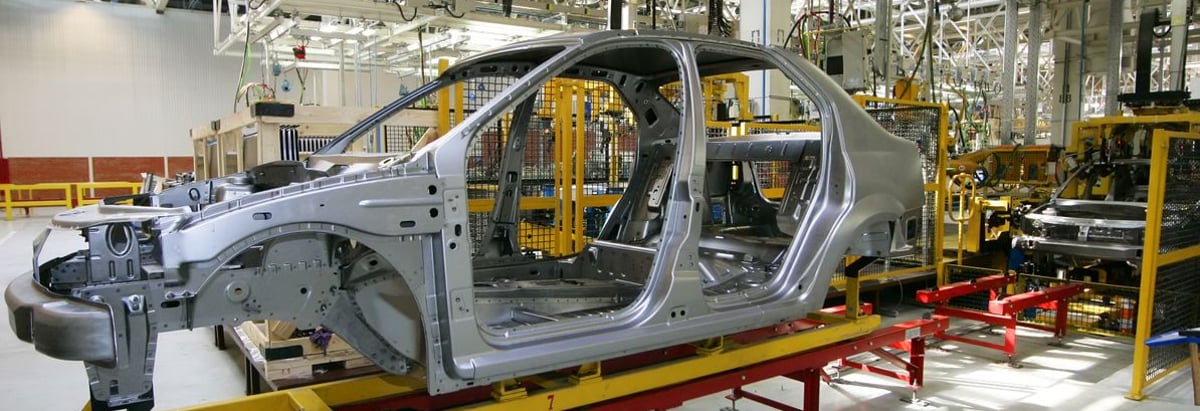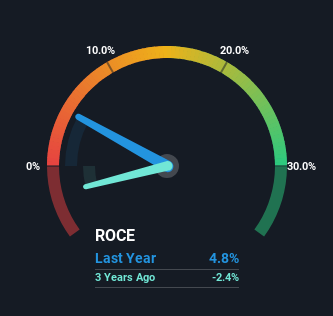Slowing Rates Of Return At Nissan Motor (TSE:7201) Leave Little Room For Excitement

If we want to find a stock that could multiply over the long term, what are the underlying trends we should look for? Firstly, we'll want to see a proven return on capital employed (ROCE) that is increasing, and secondly, an expanding base of capital employed. If you see this, it typically means it's a company with a great business model and plenty of profitable reinvestment opportunities. Although, when we looked at Nissan Motor (TSE:7201), it didn't seem to tick all of these boxes.
Return On Capital Employed (ROCE): What Is It?
Just to clarify if you're unsure, ROCE is a metric for evaluating how much pre-tax income (in percentage terms) a company earns on the capital invested in its business. The formula for this calculation on Nissan Motor is:
Return on Capital Employed = Earnings Before Interest and Tax (EBIT) ÷ (Total Assets - Current Liabilities)
0.048 = JP¥566b ÷ (JP¥19t - JP¥6.9t) (Based on the trailing twelve months to December 2023).
Thus, Nissan Motor has an ROCE of 4.8%. Ultimately, that's a low return and it under-performs the Auto industry average of 12%.
View our latest analysis for Nissan Motor

In the above chart we have measured Nissan Motor's prior ROCE against its prior performance, but the future is arguably more important. If you'd like to see what analysts are forecasting going forward, you should check out our free analyst report for Nissan Motor .
What The Trend Of ROCE Can Tell Us
There hasn't been much to report for Nissan Motor's returns and its level of capital employed because both metrics have been steady for the past five years. This tells us the company isn't reinvesting in itself, so it's plausible that it's past the growth phase. So don't be surprised if Nissan Motor doesn't end up being a multi-bagger in a few years time.
The Bottom Line
We can conclude that in regards to Nissan Motor's returns on capital employed and the trends, there isn't much change to report on. Since the stock has declined 37% over the last five years, investors may not be too optimistic on this trend improving either. In any case, the stock doesn't have these traits of a multi-bagger discussed above, so if that's what you're looking for, we think you'd have more luck elsewhere.
One more thing: We've identified 2 warning signs with Nissan Motor (at least 1 which doesn't sit too well with us) , and understanding these would certainly be useful.
While Nissan Motor may not currently earn the highest returns, we've compiled a list of companies that currently earn more than 25% return on equity. Check out this free list here.
Valuation is complex, but we're here to simplify it.
Discover if Nissan Motor might be undervalued or overvalued with our detailed analysis, featuring fair value estimates, potential risks, dividends, insider trades, and its financial condition.
Access Free AnalysisHave feedback on this article? Concerned about the content? Get in touch with us directly. Alternatively, email editorial-team (at) simplywallst.com.
This article by Simply Wall St is general in nature. We provide commentary based on historical data and analyst forecasts only using an unbiased methodology and our articles are not intended to be financial advice. It does not constitute a recommendation to buy or sell any stock, and does not take account of your objectives, or your financial situation. We aim to bring you long-term focused analysis driven by fundamental data. Note that our analysis may not factor in the latest price-sensitive company announcements or qualitative material. Simply Wall St has no position in any stocks mentioned.
About TSE:7201
Nissan Motor
Manufactures and sells vehicles and automotive parts worldwide.
Adequate balance sheet with moderate growth potential.


